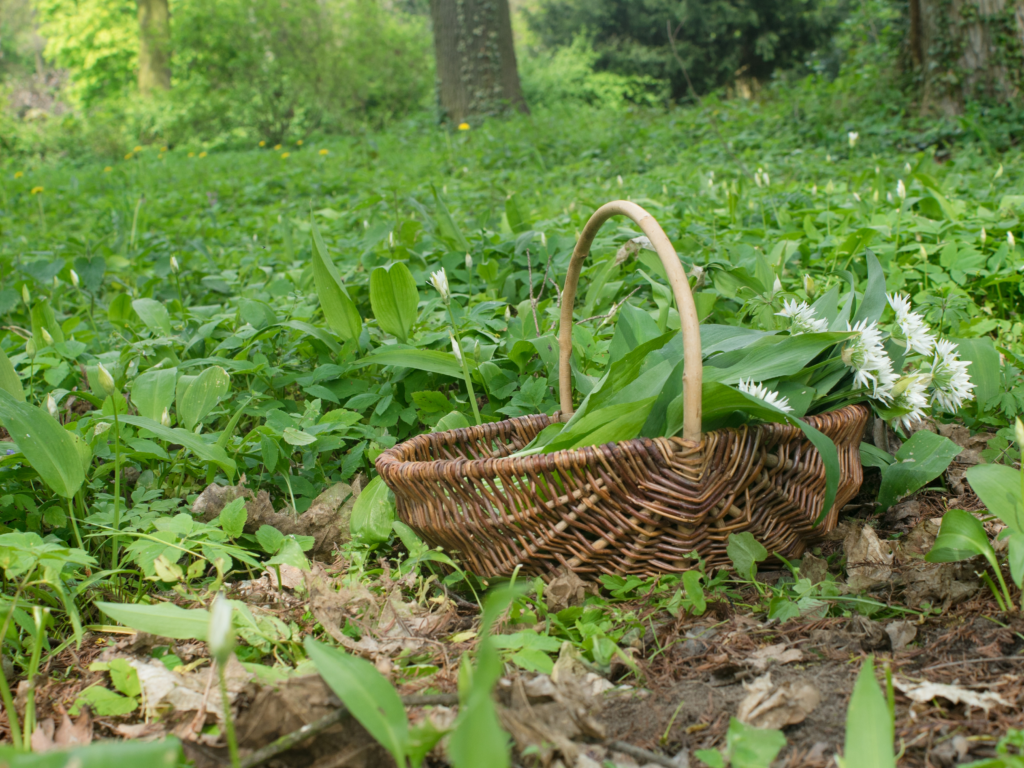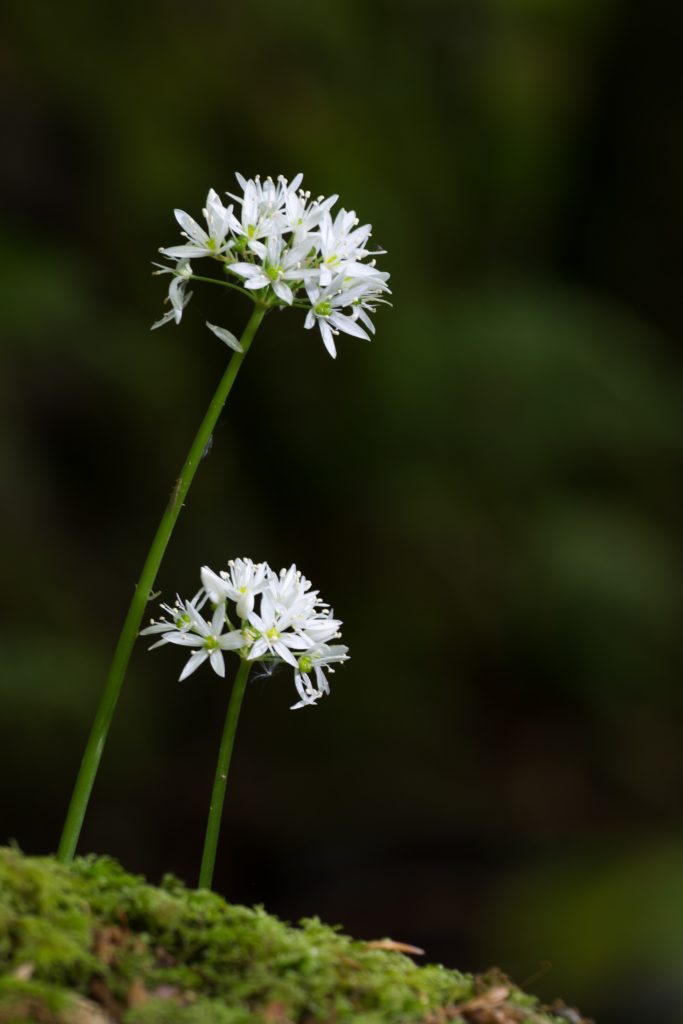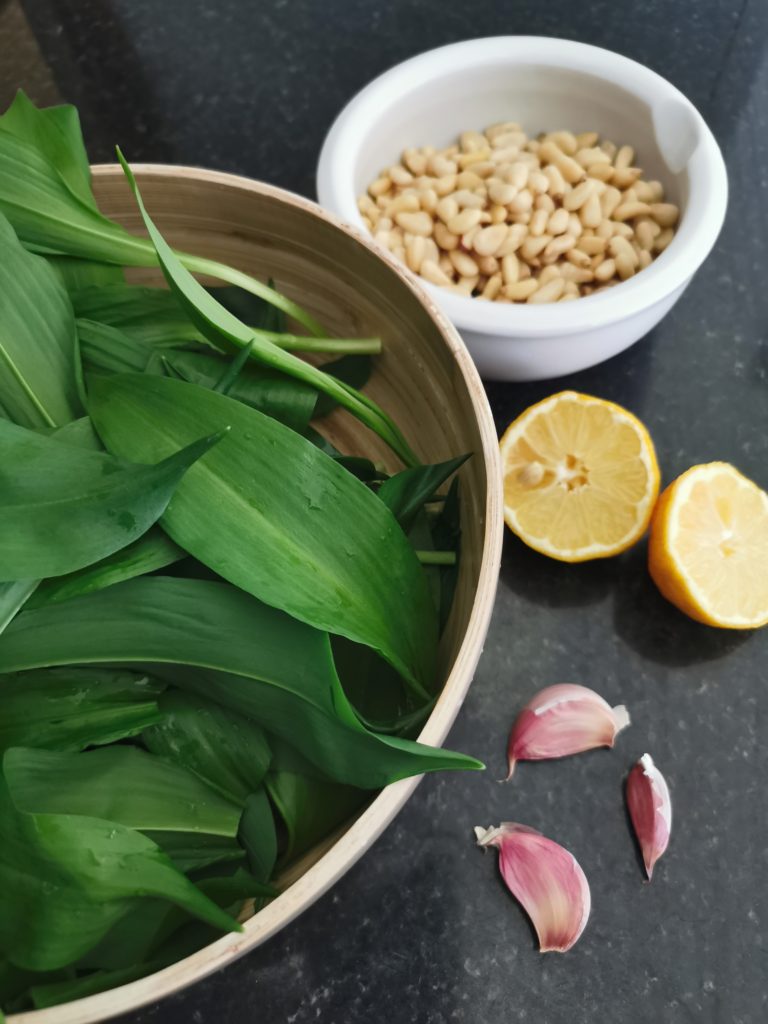One of the earliest plants to forage for in Spring is wild garlic. It’s broad, bright green leaves appear in early March and they go on to flower from April to June. Here I share a little about this wonderful plant as well as my recipe for Wild Garlic Pesto.
Wild garlic, Latin name Allium ursinum, is an herbaceous perennial flowering plant native to Europe and Asia. It grows in damp woodlands from small bulbs and is a wild relative of the more commonly known garlic.
Other commonly known plants found in the Allium genus are onions, shallots, leeks and chives. Allium is the Latin word for Garlic which definitely describes these strong smelling and tasting plants.
How to identify wild garlic
Wild garlic has broad spear shaped leaves with pointed tips and smooth edges. The leaves vary in size from 5-15cm in length and 3-6cm wide. Each leaf has one main central vein running from the stem to the tip.
Wild garlic produces clusters of white, star shaped flowers that form on a long straight stem. Flowers usually appear before deciduous trees get their leaves in Spring. Wild garlic reproduces easily by seed so they quickly spread and create great carpets in the undergrowth.
Caution
Wild garlic leaves look similar to Lily of the Valley and Lords and Ladies which are both poisonous. You can check that you have wild garlic by crushing a leaf between your fingers. If it smells like garlic, then you have the right plant*.
*Just make sure that the smell doesn’t remain on your hands if you are checking different areas. You may mistake this and pick a poisonous plant by accident!
You can find a more in depth video tutorial on identifying wild garlic here.
Where to find wild garlic
Wild garlic often grows in the same wooded areas as Bluebells. Both plants are known as indicators species of ancient woodlands which are home to many rare and threatened mammals, birds and insects.
Many ancient woodlands are protected by law so you should seek permission before foraging on any land that is not your own.
If you are new to foraging, then why not check out my Field Guide for First Time Foragers post. It has lots of great hints and tips as well as important dos and don’ts for foraging safely.
Foraging Notes
When foraging for wild garlic, pick young, tender leaves from the plant before the flowers appear. Remember to pick leaves that are away from busy roads, fields or dog-walking tracks and wash well before using.
All parts of the wild garlic plant are edible. Here’s a quick rundown of what can be used, when and how.
- Stem and leaves – collect in early Spring
Use as a salad item or wilted like Spinach. They can be used to flavour oils and of course for making pesto (read on for our recipe and pesto uses)
- Flower buds – collect in April
Can be pickled or used in tempura (use the long stem as a handle when frying)
- Flowers – Collect around May time
Use as garnishes or in salads
- Seeds – Collect between May and June
Use as a garnish, in salads or as a spice while cooking
- Bulb – Collect between July and March. Use as you would regular garlic
Fun facts
Hoverflies
Wild garlic is known by many different names. One of the most common is Ramsons. This is because the Ramsons Hoverfly uses wild garlic plants as a sort of nursery for their developing larvae. They lay their eggs in the surrounding soil and the larvae dig down and overwinter by the wild garlic bulbs before emerging the next year. Cute!
Brown bears
An old folk name for wild garlic is “bear garlic”. This comes form the belief that brown bears love to feast on the wild garlic bulbs after hibernation. This association has also been linked way back in old mythology with the wild garlic species name ursinum. A theory suggests that this is linked to Ulsa Major, a constellation in the northern hemisphere which translates from Latin as ‘Greater She-bear’.
Wild garlic pesto recipe
A fresh and tasty way to use foraged wild garlic this Spring, pesto is both quick and easy to make. Follow the recipe below to make your own, there are substitutes and alternatives listed for easy alterations.
Ingredients
- 150g wild garlic leaves (you can top up with basil or young nettle leaves if needed)
- 50g parmesan cheese (or vegan alternative) finely grated
- 50g pine nuts (can be substituted for walnuts or sunflower hearts or a mix depending on what you have available)
- 1 garlic clove peeled and crushed (leave out if you want a milder pesto)
- ½ a lemon zested and squeezed
- 150ml olive oil (rapeseed oil works just as well too)
- Salt and pepper to taste
- Clean, empty and sterilized glass jars with lids for storage*.
*See post How to Clean & Reuse Glass Food Jars for instructions on how to sterilise your jars safely.
Method
- In a dry frying pan, toast the pine nuts over a low heat until lightly golden and set aside.
- Wash the wild garlic leaves thoroughly, pat them dry and roughly chop.
- Use a food processor or stick blender to blitz the chopped wild garlic leaves, toasted pine nuts, parmesan, crushed garlic clove, lemon zest and juice together. (You can use a pestle and mortar here instead if you are feeling particularly traditional!)
- Continue to mix on a low setting and slowly add most of the olive oil, keeping some to top the jars up with at the end.
- Season with salt and pepper to taste and then transfer to your clean and sterilised jars.
- Use the remaining oil to top up the jars and seal with their lids.
- Label and date the jars, keep refrigerated and use within 2 weeks.

Pesto uses
Wild garlic pesto can be used in a variety of delicious dishes. Below are just a few examples of how we use ours.
- Stir through cooked pasta and add fresh chopped tomatoes and ground black pepper.
- Add a dollop on poached eggs and serve with toast, buttered mushrooms and mashed avocado.
- Drizzle over homemade pizza topped with mozzarella and tomato passata.
- Mix it in with roasted potatoes for a tasty side dish.
- Or knead into bread dough before baking.
- Wild garlic pesto is also great added to meat and fish either as a topped sauce or baked in the oven.
So there you have it, my guide to wild garlic and this tasty and versatile pesto recipe. Enjoy!
If you try this yourself or have any other pesto recipes, then please share them in the comments below.
Thanks so much for reading,
Dee






Pingback: Field Guide for First Time Foragers